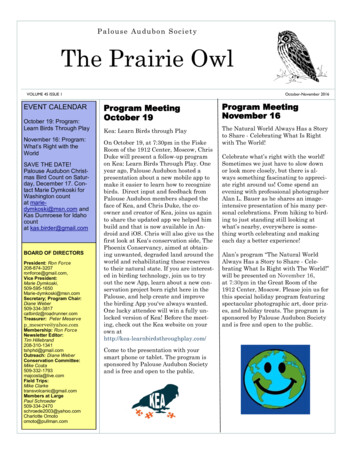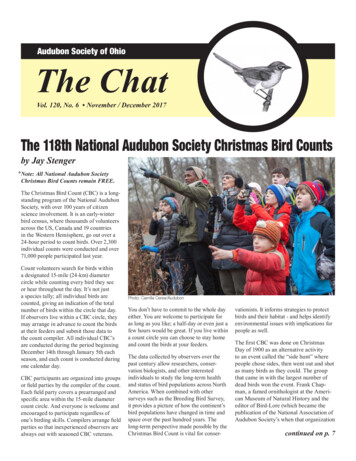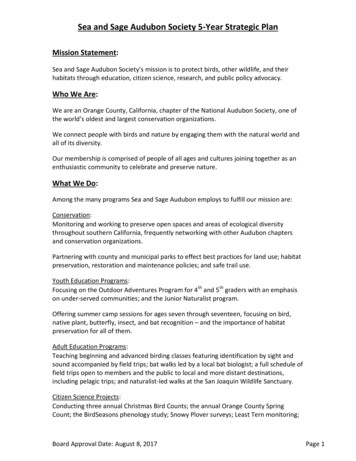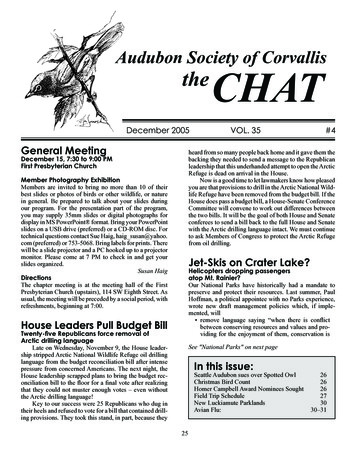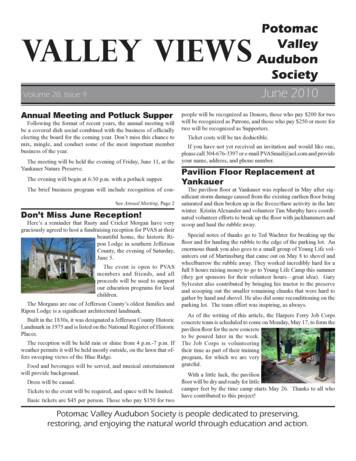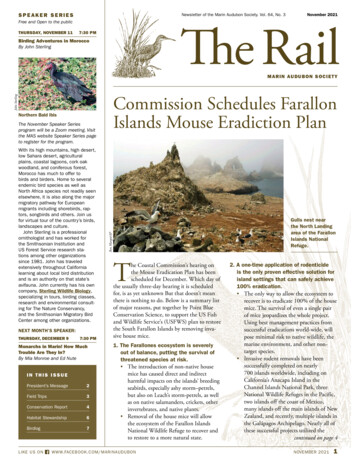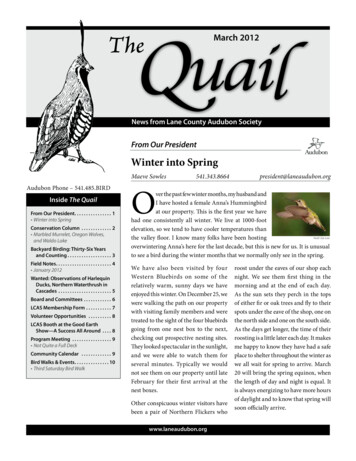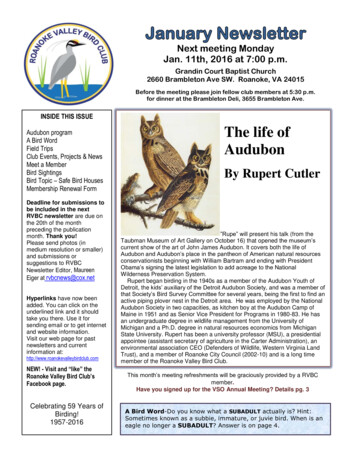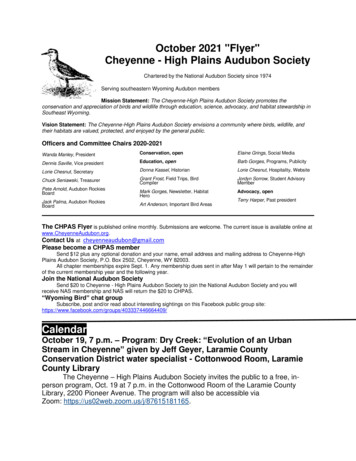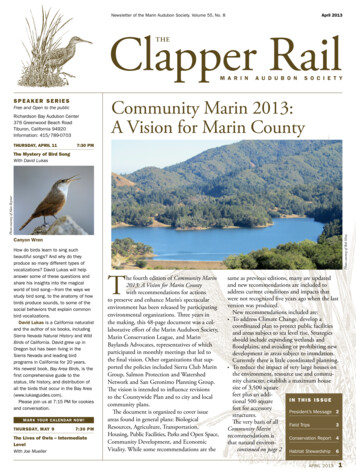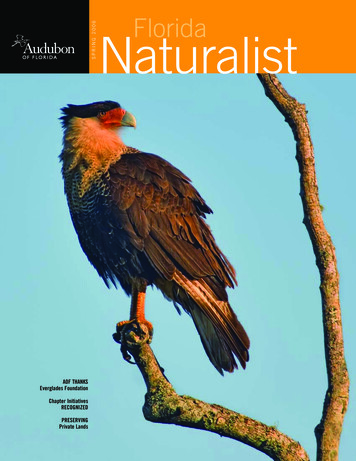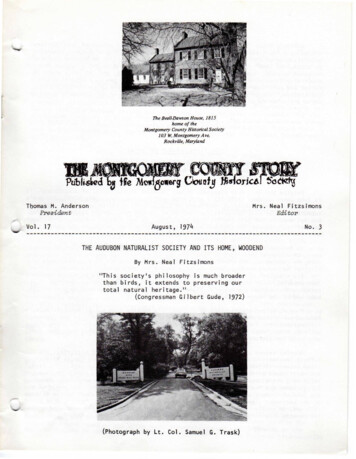
Transcription
The Beall-Dawson House, 1815home of theMontgomery County Historical Society103 W Montgomery Ave.Rockville, MarylandTbomas M. AndersonPresidentVo I.17Mrs. Neal FitzsimonsEditorAugust, 1974THE AUDUBON NATURALIST SOCIETY AND ITS HOME, WOODENDBy Mrs. Neal Fitzsimons"This society's philosophy is much broaderthan birds, it extends to preserving ourtotal natural heritage."(Congressman Gilbert Gude, 1972)(Photograph by Lt. Col. Samuel G. Trask)No. 3
-2-Editor's Note: The Historical Society has in the past published "old" history,including a few histories of early homes in the county. Along with their extensivegrounds, many of these landmarks could not be preserved. Although Woodend is locatedon a Colonial land grant, Clean Drinking, in Chevy Chase, it is not a vintage mansioncompared to some. However, the house, the gatehouse-garage, and the forty acres ofmanorial grounds were bequeathed to the Audubon Society to use as a natural wildliferefuge and environmental center. It is an impressive example of "p rese rva t lon byut lllze t lon," rather than obliteration. We wish that more of our landmarks could receive a similar fate.The First Audubon SocietiesIIFor two closely related purposes - the studyand protection of b lrds ;!' (May 18, 1897)Despite the fact that-Alexander Wilson is known as the father of ornithology, itis John James Audubon (1785-1851) with whom most Americans associate birds. Audubonlsfirst book, Birds of America, published in Europe in 1826 and in America in 1840, wassubscribed to by King George IV, and reprinted for the next eleven years. But Audubon isnlt acclaimed just for his bird paintings. He was Americals first out-of-doors naturalist, disappearing time and again into the wilderness to record and paint notonly Americals ornithic life but also its biota.In Audubonls journals on wildlife, there is enough of an undercurrent of uneasiness, of worry, of warnings, to label him one of our earl iest environmental ists. In1804, he carried out the first bird banding experiment and his bird counts, made invirginal backwoods country, were the only record for many years. His description ofthe 1812 slaughter of passenger pigeons and parrakeets is as vivid as Rachel Carsonls1962 description of the demise of red-win ed blackbirds and robins by chemicalsprays. He recorded the scene of fishermen clubbing to death gannets to use as fishbait and of the Ileggersilwho systematically robbed nests.From firsthand observations of our settlers hack1ng into our primeval forests,Audubon envisioned the disappearance of some species of wildlife due to the Ilgradualdiminution of our forests.11 In 1842 he made note of the decrease in the herds ofbuffalo, even though "da l ly we see so many that we hardly notice them more than thecattle in our pastures about our homes .!'America seemed to be a long time in recognizing the plight of wildl ife. Thebuffalo, extinct in the east around the time of our Revolution, was nearly annihilated between 1865-85 when the railroads allowed easy access to the west. The landand water bound birds, the Dodo, the Solitaire, and the great Auk, unable to takeswift wing and escape man, were extinct by 1844. By 1878 the Labrador Duck, famousfor its down and feathers, and migrating as far south as New Jersey, had vanished atthe hand of commercial hunters. Even though ornithologists were alert to the dilemmaof the passenger pigeons, they could not save them. The last one, Martha, died in1914 and, in stuffed form, reposes at the Smithsonian from where she exhibited aroundthe country like a rare jewel. Other species of birds were greatly diminished.
-3The first Ornithological Club was organized in Massachusetts in 1873. The American Ornithologistsl Union came into being in 1883, which led to the appropriation of 5,000 by Congress for a Biological Survey, and small state and local bird groups began to organize. In 1886 the term "Audubon Society" was coined by Dr. GeorgeGrinnell, an ex-student and neighbor of Mrs. Audubonls. Dr. Grinnell, editor ofField and Stream Magazine, was part of the group of Americans who became alarmed overthe slaughter of birds for the millinery trade. Womenls hats were made of the wholeskins of gulls and terns and many were ornamented with elaborate feathers and b-righ.tplummage. Although Dr. Grinnell IS society collapsed, the name of Audubon caught onand in 1897, the Audubon Society was organized in the District of Columbia "for theprotection and study of birds." It wasted little time. The first lecture was "Womanas a Bird Enemy." Despite a concerted effort to educate the public, fashion musthave continued to dictate, for at its first annual meeting, the Audubon Society wasstill concerned:It is now becoming known that some of our mostbeautiful birds have been all but exterminatedto supply the demands of millinery .Few people realize, until their attention is calledto it, what it means to wear birdsl wings andheads on onesl hat.George Miller Sternberg, Surgeon-General of the U. S. Army, served as the firstPresident for eighteen years. All the committees, except the Millinery Committee,were routine and and since it was before the era of bumper stickers or saucer-sizedbuttons, a delicate bird pin was designed. The first major publication by the Audubon Society was The Birds of Washington and Vicinity (1898), but it was leaflets suchas liThe Birdsl Message to Children," "A Hint to Mothers," and "Some Common Birds inRelation to Agriculture" that caused public awareness. A "bird day" was set aside inthe schools and the Audubon Society trained people to conduct bird identification andawareness classes. The National Geographic is also credited with awakening the general public interest in birds.The 1900 Lacey Act offered the first comprehensive Federal law for bird protection. In 1901 the first local law was enacted "for the protection of birds andeggs .11 S lowly other laws were passed and the egrets and terns and other birds thatwere nearly extinguished by the mill iners were allowed to rebuild their population.In 1903, President Theodore Roosevelt designated the first Federal wildlife refuge inFlorida. A National Audubon Society was formed in 1905 with headquarters in NewYork, but the local Audubon Society elected to remain independent. Internationalagreements were legislated such as the 1913 Act to terminate the importation of wildbirdsl feathers and the 1918 Migratory Bird Treaty Act between the United States andCanada.Americals depression years were beneficial to wildlife, for governmental programs bringing help to agriculture led to emphasis on soil and water conservation,land use, and provision for wildlife. Conservation and game management required abroader knowledge of ecology, bringing the laboratory-confined scientist out of hisnarrow role. The public took interest in the wildlife sanctuaries and pursued laynature studies.Documentaries on wildlife shown in movie theatres, even before the "talkies"caused great public enthusiasm and gave people an insight into wildlife from distantareas. President Theodore Roosevelt, an active member of the Audubon Society (heturned in a bird count of the White House grounds), hosted a gala showing of thefirst bird movie in the East Room in 1908. Occasionally movies featured bird-watching
-4vignettes, as when a group with binoculars making bird counts would shush interlopers;or a bird-watching group stumbling upon a body in the woods would indicate a mysteryplot. However, after World War lithe Audubon Society became less of a bird-watchingsociety and more involved with the totality of our environment. Irston R. Barnes,President of the Audubon Society from 1947 until 1961, explained:A group of young and enthusiastic leaders cameinto the Audubon Society during and immediatelyafter the War [World War 1 I]. Many of the newrecruits were as much concerned with conservation problems as they were with the enjoymentof birds .Also, many of the new members were trained and proficient workers in naturalhistory fields such as the Fish and Wildlife Service, the Forest Service, and theSmithsonian Museums. The Audubon Society began to offer year around field trips,seminars and lectures on field botany, geology, weather, ecology and conservation inaddition to the basic bird courses. And according to Mr. Barnes, "eminent citizenswho would never have joined a bird club but who were anxious to support a real isticand dedicated conservation program" were attracted by the Audubon Society.Realizing their potential as an educational and scientific organization, theAudubon Society became an incorporated entity in 1947. Again, Mr. Barnes expressedthe society's new turn:We can be a forum for education in natural history and conservation that will influence publicand private programs throughout the country.The Audubon Society had already influenced several large scale programs concerning an increasing encroachment upon local natural areas; the proposal to construct asuper highway through the C & 0 Canal in the 1930's, and Maryland Route 240 throughRock Creek Park in the 1950's. Most importantly, the society joined in forming andsupporting groups such as the Potomac Valley Conservation and Recreation Council, aclearing house and mobilizer of local groups who opposed modern development planswhich needlessly destroyed natural and recreational areas.Thus, with such broadened horizons, in 1960 the Audubon Society changed its nameto the Audubon Naturalist Society of the Central Atlantic States. According toEdward F. Rivinus, President of the society from 1971 to 1974, the name change reflected:Our recognition of the whole natural environmental picture .the only animal capable ofsaving the natural environment is the animalmost capable of destroying it, man; and thatthe only way man1s destructive inclinationscould effectively be disciplined is througheducation.The Audubon Society's attempt to educate man in his role as predator has alsoincluded the one of educating man on the role of nature's own predators. Men likejack Miner and Charlton Ogburn have probably made the most extreme comments onnature1s own circle of brutality. To Jack Miner, who is remembered by many for theScripture messages he placed on migrating ducks and geese, it was simply a matter ofkilling all predators. Mr. Ogburn, in The Winter Beach, was more philosophical. He
-5gave a long listing of predators and chastised Rachel Carson for calling a tidal pool"that enchanted place" when to him it was "a far-worse-than Roman arena" wherein:lithe Tubularia had tentacles for petals with which it reached out to ensnare the infant larvae of mullusks and crustaceans," and some species of Nemertea "grew to monsters up to ninety feet long and yanked their victims into their mouths in the coilsof a whiplike appendage." Mr. Ogburn comforted himself when writing of those preyedupon:The brief, horror-beset existence we ascribeto them would surely be unrecognizable tothem . To suffer vicariously is given to manalone.Perhaps Harold Mayfield best explains it:Predation .is a hard thing for many people tounderstand . .no simple explanation is adequateto explain the complete relationships amongliving things .But as our understandinggrows, we are coming to appreciate more fullythat every wild creature has its place.--To the Audubon Society, the wild creatures still need to be protected from commercial interests. If the birds of yesteryear needed protection from the mill iners,today's mammals need safety from the furriers and tanners. And both animal and manneed extensive research on the harm of chemical poisoning.Not only are chemicals in our environment of grave concern to the Audubon Society but it is also concerned with the invasion of wildlife territory by man as heliterally takes lebensraum from the animals. The society's publications on scientificstudies of the population factor have added yet another dimension to their role.Thus, with the conservation of wildlife still its basic goal, the Audubon Societyhas extended its efforts to embrace all concepts of conservation. Their recent warning to mankind, liThe Species We Save May be Our Own," is a reminder that the AudubonSociety has come a long way since it first declared war on women's bird-trimmed hats.WoodendliThe city grew around it, but Woodend remainedan island of natural charm, with its screening of woodland."(Irston Ba rnes, 1969)The Audubon Society operated from its bookstore at 1621 Wisconsin Avenue fornearly ten years; before that from members' homes and a post office box. A mimeographed sheet, the "Wood Thrush," first published in 1947, grew into an informativequarterly journal, the Atlantic Naturalist. No longer having a reputation for just a"bird watching" and study group, surely the society needed a sanctuary of its own.In 1967 the Audubon Society was recipient of a 30-room mansion on forty acres ofland in Chevy Chase, which was part of a Colonial land grant known as Clean Drinking.In Old Manors in the Colony of Maryland - On the Patuxent, Annie L. Siousset states
-6-that Clean Drinking, which originally consisted of about 1,400 acres, was "taken Up"by Col. John Courts of Sproxton, Yorkshire, in 1680 and patented in 1699. CleanDrinking acquired its quaint name when the surveyors were told that they had "drunkclean" all the available alcoholic spirits and would have to resort to nearby springwater.The Clean Drinking grant remained in the Courts family name until the fourthJohn Courts sold 350 acres to his sister, Elizabeth, who in 1747 married CharlesJones. The Jonesl erected the manor house in 1750.Clean Drinking was one of the most self-contained agricultural units in thecounty. It had swift-flowing Rock Creek to furnish power for a mill and for watersupply, a dairy house, stone kitchen, slave quarters, gardens, private cemetery, andthe twin-chimney house where, in the words of Historian Thomas Scharf, lithe planterdispensed a generous and often courtly hospitality." Clay, Webster, and Calhoun wereentertained there. George Washington's diary makes reference to his stopping atClean Drinking for a rest and visit on his return from the ambushcade and retreatfrom Fort Duquesne in 1755. During the War of 1812, the national post office wasmoved to Clean Drinking for safe keeping from the British. The Jones family figuredprominently in the Revolution and in early state and county government. Until hisdeath in 1911, collateral descendent Nicholas Jones occupied the house. He wasalleged to be so fond of his ancestral home that he would not allow changes or repairs, so the house literally tumbled down. Simpson and Yardley described the colorful gentleman and his vintage house:The arrangement of the back rooms and of thesecond floor is not known since the lastoccupant, Nick Jones, would not admit callersto those parts of the house. The enormousdoor knobs appeared to be made of solid brassand they, and the other brass objects, includingthe andirons, were kept brilliantly polished,which accentuates the rather 'dowdy' appearanceof the structure as a whole. Magnificent boxwoods lined both sides of the path leading fromJones Mill Road to the house.
-7-Nicholas Jones, shown here c. 1898, on his porch at Clean Drinking Manor.The house tumbled down in the early 19001s.It was built in 1750.In 1970, under the supervIsion of the Historical Society (BobBraunberg, Curator), archeological digs were undertaken on theout-buildings of Clean Drinking Manor. Shirley Briggs (center,standing), working from Woodend, organized the digs just beforethe site was razed for construction of the Bethesda-SilverSpring Retirement and Nursing Home Center.
-8-In 1916, Clean Drinking left the Jones lineage when Robert C. Jones sold it toNavy Captain and Mrs. Chester Wells. Six years before that, the Wells' had purchaseda farmhouse and approximately ten acres from Charles Barber and they ultimately acquired about 100 acres of adjacent land. Discarding the idea of rebuilding and enlarging on the ruins of Clean Drinking, the Wells' built their mansion, Woodend, on anearby elevation, preserving the chimneys and foundation of the old Jones house, theremaining out buildings, garden wall and the boxwoods. (The Jones family cemeterywas moved to Rock Creek Cemetery). In addition, Mrs. Wells added something new birdhouses - in the woods and around the gardens she laid out at Woodend.Mrs. Wells, ne' Marion Dixson, was an Austral ian heiress who met Capt. Wellswhen he was on a Navy mission in her country. Married in 1908, the Wells' decided,when Capt. WeI Is was serving Navy duty in the Washington area, to build their permanent home in Chevy Chase. Mrs. Wells commissioned John Russell Pope, who designedthe National Gallery of Art, the National Archives Building, and the Jefferson Memorial, to design Woodend and to duplicate some of the features of her father's estatenear Sidney. Despite the illustrious reputation of Mr. Pope, Mrs. Wells, a strongminded woman, had him build the five-stall garage before she allowed him to proceedwith the house.Garage-gatehouse at Woodend, 1974.(Photograph by Lt. Col. Samuel G. Trask)
"'9-Woodend dominates the knoll it occupies.It combines the stately elegance ofthe Georgian style with the balustered roof line of the Greek Revival ists. By meansof a low profile hip roof, the partial third story is concealed from viewers on theground. Flemish bond walls are pierced with tall white, woodframed windows which aredominated by a grey keystone in a brick flat arch lintel. The main entranceway, alsowhite, is typically Georgian, having a neo-classical double-sconce pediment over thedoor which stands between Corinthian pilasters. The general plan of the mansion isrectangular with an ell-wing on the west side. The "great ha ll," which contains themain staircase, is entered from the east. A small, semi-circular, collonaded porticoattached to the east wing overlooks the area that once contained the Wells· formalgardens.The rooms of Woodend generally have high ceil ings and either wood or plasteredpaneling. Fireplaces can be found in all the formal rooms and in the main bedrooms.With six rooms for servants at the main house and three others over the brick garagelocated about 200 yards down the hill, it is easy to see that Mr. Pope planned tohave the estate well maintained for the Wells· and their guests.The original coal-burning heating plant appears to have been large enough for amodest-sized hotel. It is not too surprising when one considers that this mansioncontains about 10,000 square feet, excluding the basement (which has a vaulted winecellar), or about eight times the footage in the average home in suburbia. The housealso contains the first underground electrical in-service facilities installed inthis area.Woodend, c. 1969. Designed by John Russell Pope in 1927.(Courtesy of Ben Osborn, Audubon Society)
-10-Woodend was completed in 1928 but bit by bit, Mrs. Wells lost parcels of theacreage she had acquired. The Maryland Park system sequestered part of the propertythat formed. a portion of Rock Creek Park. The depression years and tax liabilitiesafter the death of Capt. Wells in 1948 made further inroads. It was in 1955 thatMrs. Wells inquired of Mrs. W. O. Spears, a fellow member of the Audubon Society,IIAnd speaking of birds, how would you like me to leave my place to the AudubonSociety?11 But Mrs. Wells had not definitely made up her mind and it seems that sheenjoyed being courted by the Audubon Society. She wanted assurance that all would bewell cared for. Ever the entertaining hostess, she announced at a Christmas partythat she would leave her beloved house and forty acres to the Audubon Society afterher demise. She died in 1967 in her eighties and was buried at Arlington NationalCemetery. Two portraits of Mrs. Wells - one with her two adopted daughters - and aportrait of Capt. Wells, still hang at Woodend.The Audubon Society, whose membership totals approximately 2,300 (one-thirdcomes from Montgomery County), uses the first floor of Woodend for meeting rooms.The second and third floors are working offices and Iibrary. The Rachel Carson Trustfor the Living Environment has offices at Woodend; Miss Carson was an Honorary VicePresident and Board member of the Audubon Society. The George Whittel 1 MemorialField Ecology Center and classrooms are located in the gatehouse-garage.Graduatecourses are taught in cooperation with the Department of Agriculture. The AmericanForest Institute has initiated a tree farm project on the Audubon grounds. In addition, the grounds will be sectioned off so that an inventory of existing wildl ife canbe recorded and studied. About 28 species of resident birds have already beencounted at Woodend, and it is expected that Woodend wil I be included in the traditional Christmas and spring bird counts.One cannot help but feel that Mr. Nicholas Jones, the quixotic gentleman soproud of the past, and Mrs. Chester Wells, the futurist so concerned with openspaces, would approve of present day Woodend. Preservation of the mansion for use asAudubon Society Headquarters and of the grounds as a sanctuary and for field studiesis an admirable endeavor. It is clearly an effort that the "don t t tear it downers"would applaud.Mr. Stanwyn G. Shetler, President of the Audubon Society, and Mrs. Hannah B.Arnold, its Headquarters Manager, were most helpful in granting interviews. Mrs.Laurie Hess, a descendent of the Jones family, and Miss Shirley Briggs, ExecutiveSecretary of the Rachel Carson Trust, were also generous with their time,The Editor
-11-BIBLIOGRAPHYAdams, Alexander.John James Audubon.New York:Barnes, Irston R. "Our Recent Years."12 (April-June 1957) 153.AtlanticBriggs."Sixty Years in Retrospect."12 (Jan.-March 1957) 83.Briggs."A Seventy-Year Prospective."22 (April-June 1967) 67.·24 (SpringCarson,Rachel."Mrs. Wells at Woodend."1969) 14.Silent Spring.Boston:Dock, George."Audubon as a Prophet."12 (Jan.-March 1957) 91.G. P. Putnam'sNaturalist,AtlanticThe HoughtonAtlantic1966.ed. ShirleyNaturalist,AtlanticAtlanticSons,Briggs.ed. ShirleyNatural ist, ed. ShirleyNaturalist,MifflinNaturalist,ed. ShirleyBriggs.Co., 1962.ed. ShirleyBriggs.Evans, Jesse Fant. "District Scout Counci 1 Head Now Owns Famed Maryland Estate Woodend Includes Ruins of Historic Clean Drinking Manor House."Sunday Star.1937.Mayfield, Harold."Jack Miner - and the Role of Predators in Nature."Naturalist, ed. Shirley Briggs.11 (March-April 1956) 172.Ogburn,Charlton.The WinterBeach.New York:WilliamRivinus, Edward F. "Three Targets of Conservation."Osborn.27 (Summer 1972) 74.Scharf, Thomas."Montgomery County."HistoryRegional Publ ishing Co., reprinted 1968.Sherwood, John."Her Last, Sad Flight."Marrow & Co., 1966.Atlanticof WesternAtlanticNaturalist,Maryland.Washington-Star News.ed. Ben O.Baltimore:(June 26, 1974).A-3.Simpson, Robert and Yardley, Edward.Archives, Audubon Society.A Brief History of North Chevy Chase.Spears, Mrs. W. O. "A Reminiscence on Woodend and Mrs. Wells."ed. Shirley Briggs. 24 (Summer 1969) 85.1953.Atlantic Natural ist,Wade, J. E. "Early Days of the Audubon Society."Briggs. 11 (March-April 1956) 156.Atlantic Naturalist, ed. ShirleyWi lson, John S. "Historic Clean Drinking Manor."(March 1896) D. A. R.American Monthly. VIII
areas. President Theodore Roosevelt, an active member of the Audubon Society (he turned in a bird count of the White House grounds), hosted a gala showing of the first bird movie in the East Room in 1908. Occasionally movies featured bird-watching Americals depression
